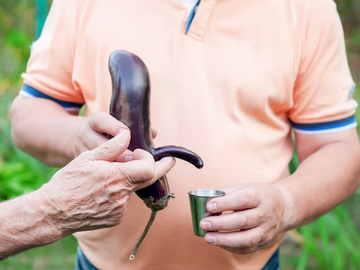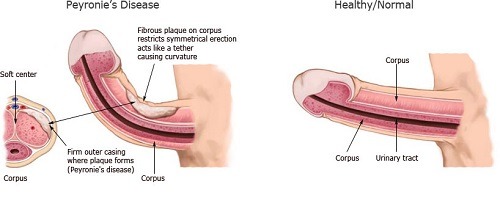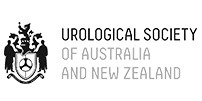Every man’s penis is unique, characterised by individual variations in shape, size, and curvature. It’s essential to understand that a slight bend or curvature in the penis is typical for many men. This natural bend can be due to the penis’s anatomy or how the corpora cavernosa (the chambers that fill with blood during an erection) expand.
However, when a man notices a pronounced or sudden curve in his penis, especially if accompanied by pain, it could be indicative of an underlying condition or issue.
Let’s delve deeper into the reasons why some penises bend more than others, plus the psychological impact and potential treatments to consider.
Reasons Why a Penis Bends
1. Peyronie’s Disease
This is one of the most common causes of a significant penile curvature. Peyronie’s Disease – or PD – results from scar tissue, called plaque, forming inside the penis. The plaque can cause the penis to bend or curve when it’s erect.
Causes of Peyronie’s Disease
The exact cause of this condition remains unknown, although there are several contributing factors as follows:
- Repeated Penile Trauma: Vigorous sexual activity, sports injuries, or accidents can lead to minor traumas. Over time, these can result in scar tissue formation.
- Genetic Factors: A family history of PD might increase one’s risk.
- Autoimmune Factors: Some believe that PD might be the body’s autoimmune response, where it mistakenly attacks its tissues.
- Medications: Some drugs have been linked to PD, although evidence is inconclusive.
2. Congenital Curvature
Some men are born with a bent penis, which is called congenital penile curvature. This condition is not associated with any disease process and is merely a result of the penis’s development.
3. Injury or Trauma
Injuries to the penis can cause bleeding inside, leading to scar tissue formation. This scar tissue might not be as flexible as the surrounding tissue, causing a bend or curve when the penis is erect.
4. Vascular Issues
Sometimes, differences in blood flow can lead to a bent appearance. If one side of the penis receives more blood flow than the other during an erection, it could cause an uneven expansion, leading to a curve.
5. Penile Surgeries
Surgical procedures on the penis, especially those for conditions like penile cancer or for penile implants, can sometimes result in curvature due to changes in tissue or scar formation.
6. Age
As men age, various changes can occur in the penile tissue. Elasticity can decrease, and there might be differential growth of tissue, leading to a curve in the penis.
If a man is concerned about the curvature of his penis, especially if it’s causing pain or difficulty during sexual intercourse, it’s crucial to consult a urologist or a healthcare professional. A specialist can provide a proper diagnosis and suggest potential treatments or interventions if it is felt needed.
The Psychological Impact of a Bent Penis
Beyond the physical discomfort, a bent penis can have profound psychological effects. Men may experience:
- Low Self-esteem: Feeling different or “abnormal” can lead to feelings of inadequacy.
- Relationship Strain: Physical discomfort during intercourse can put a strain on intimate relations.
- Mental Health Issues: Prolonged stress and anxiety about one’s condition can lead to depression or anxiety disorders.
The Social Implications
Men with a bent penis often feel isolated due to the stigma associated with the condition. Society’s emphasis on “normalcy” can exacerbate feelings of alienation. It’s essential for men to understand that they’re not alone and that support is available.
How to Straighten Your Penis
Addressing a bent penis depends on the severity of the curve and associated symptoms. The approach to treatment can vary from non-invasive methods to surgical interventions, depending on the individual’s specific condition and needs.
Non-surgical treatments:
- Medications: Drugs like Verapamil or Collagenase can be injected directly into the plaque tissue. These medications work by potentially softening the scar tissue and reducing curvature. It’s essential to note that while some men experience significant improvement, others may only see minimal changes.
- Traction Devices: These are specially designed devices worn on the penis for several hours a day. Over time, they apply a gentle and consistent stretch to the penis, which can help in gradually straightening it. It’s crucial to use these devices under medical guidance to ensure safety and effectiveness.
- Physical Therapy: Gentle stretching exercises, often guided by a trained physiotherapist, might help in some cases. These exercises aim to promote flexibility and reduce the penis’s curvature over time.
Surgical treatments:
- Plication: This procedure involves removing or pinching a piece of the tunica albuginea from the side opposite the plaque. The result is a straightening of the penis. Plication is often recommended for men with more severe curvature.
- Grafting: In cases where preserving the penis’s length is crucial, grafting might be used. This procedure involves replacing the scar tissue with a graft, often sourced from another part of the patient’s body or from a donor. Grafting can help restore both the length and shape of the penis.
- Penile Implants: For men with both Peyronie’s Disease and erectile dysfunction, a penile prosthesis can be beneficial. This surgical procedure involves placing a device inside the penis, which helps achieve an erection and can also aid in straightening the curvature.
Penis Curve Prevention and Early Intervention
Understanding potential risk factors and early signs can lead to timely intervention. Regular self-examinations are crucial. Men should be on the lookout for any hard lumps or changes in the curvature of their penis. Avoiding activities that might cause penile trauma, such as rough sexual practices or playing sports without proper protective gear, can also reduce the risk.
Seeking medical advice at the first sign of abnormal curvature or pain can make a significant difference in outcomes. Early detection often leads to more treatment options and better results – not to mention an improved state of mind.
Final Words
A bent penis can be more than just a physical anomaly; it can impact a man’s self-esteem, relationships, and overall quality of life. Many men with this condition often grapple with feelings of inadequacy or embarrassment, fearing judgment or misunderstanding from partners. The psychological toll can sometimes overshadow the physical discomfort, leading to avoidance of intimate relationships, depression, or anxiety.
Knowledge is empowering. By understanding the potential causes and treatments of a bent penis, individuals can make informed decisions and seek the best possible care. It’s essential to remember that this curvature, in many cases, is a treatable condition. With the right guidance and medical intervention, men can regain confidence, restore their sexual health, and improve their overall well-being.
At Katelaris Urology, we believe in applying a holistic approach to urological health. Whether you’re exploring why do penises curve, seeking solutions for erectile dysfunction, or simply wish to understand more about men’s health, our team is here to guide you.
For a comprehensive consultation, arrange a chat with our team at Katelaris Urology.
References:
- Bilgutay, A. N., & Pastuszak, A. W. (2015). Peyronie’s disease: A review of etiology, diagnosis, and management. Current Sexual Health Reports, 7(2), 117–131. https://doi.org/10.1007/s11930-015-0045-y
- Miner, M. M., & Seftel, A. D. (2013). Peyronie’s disease: Epidemiology, diagnosis, and Management. Current Medical Research and Opinion, 30(1), 113–120. https://doi.org/10.1185/03007995.2013.842544
- Levine, L. (2013). The clinical and psychosocial impact of Peyronie’s disease. AJMC. Retrieved May 23, 2022, from https://www.ajmc.com/view/a449_13mar_peyronies_levine_s55
- Randhawa, K., & Shukla, C. J. (2019). Non-invasive treatment in the management of Peyronie’s disease. Therapeutic Advances in Urology, 11, 175628721882367. https://doi.org/10.1177/1756287218823671
- Martinez, D., Ercole, C. E., Hakky, T. S., Kramer, A., & Carrion, R. (2012). Peyronie’s disease: Still a surgical disease. Advances in Urology, 2012, 1–5. https://doi.org/10.1155/2012/206284
- American Urological Association. (2015). Peyronie’s Disease. Peyronie’s disease guideline – american urological association. Retrieved May 23, 2022, from https://www.auanet.org/guidelines/guidelines/peyronies-disease-guideline
- García-Gómez, B., García-Rojo, E., Alonso-Isa, M., Medina-Polo, J., Santos-Pérez de la Blanca, R., Justo-Quintas, J., Parnham, A., Rodríguez-Antolín, A., & Romero-Otero, J. (2020). Treatment of Peyronie’s disease with combination of clostridium histolyticum collagenase and penile traction therapy: A prospective, multicenter, single-arm study. International Journal of Impotence Research, 33(3), 325–331. https://doi.org/10.1038/s41443-020-0292-y
- Babu, A., & Kayes, O. (2020). Recent advances in managing Peyronie’s disease. F1000Research, 9, 381. https://doi.org/10.12688/f1000research.20557.1
- Hauck, E. W., & Weidner, W. (2007). Extracorporeal shockwave therapy in Peyronie’s disease. Peyronie’S Disease, 121–131. https://doi.org/10.1007/978-1-59745-161-1_11







